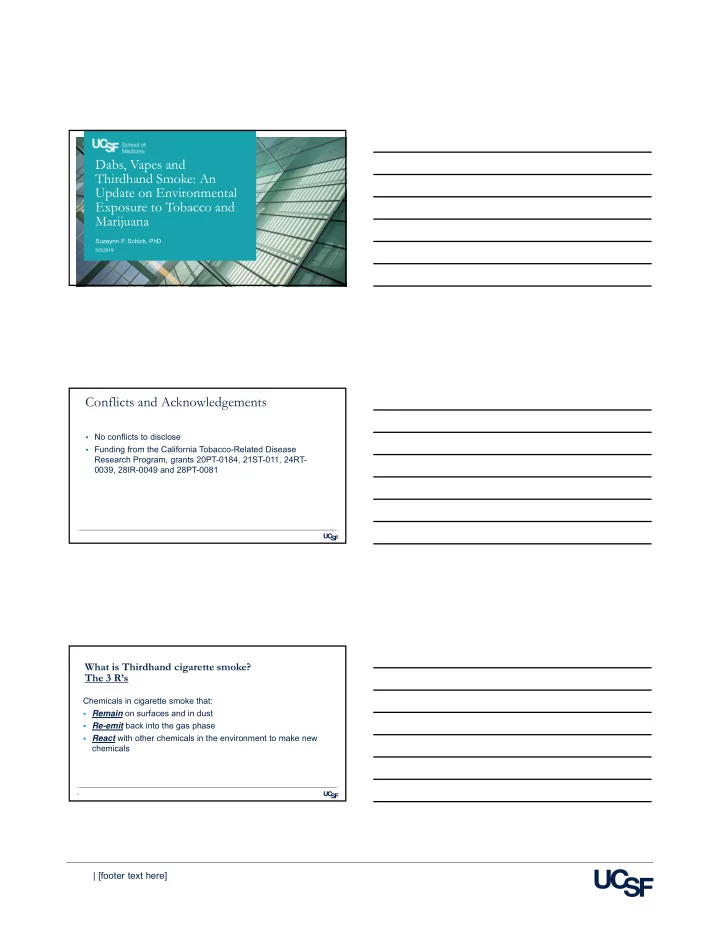

Dabs, Vapes and Thirdhand Smoke: An Update on Environmental Exposure to Tobacco and Marijuana Suzaynn F. Schick, PhD 3/5/2019 Conflicts and Acknowledgements No conflicts to disclose Funding from the California Tobacco-Related Disease Research Program, grants 20PT-0184, 21ST-011, 24RT- 0039, 28IR-0049 and 28PT-0081 What is Thirdhand cigarette smoke? The 3 R’s Chemicals in cigarette smoke that: Remain on surfaces and in dust Re-emit back into the gas phase React with other chemicals in the environment to make new chemicals 3 | [footer text here]
What is smoke? • Gases • Particles and droplets of oils and waxes (Tar) • 10% of secondhand smoke is tar Thirdhand Smoke starts with Tar 4 Remain Tar chemicals stick to surfaces before they can be removed by ventilation Walls, carpet, dust, people… Tar absorbs into porous materials Tar contains nicotine and many toxins and carcinogens Nitrosamines Polycyclic aromatic hydrocarbons Persistence increases exposure time 5 Re-Emit Combustion forces tar chemicals (normally solids or liquids) into the air Tar cools, condenses and sticks to surfaces Once on a surface, each chemical reaches equilibrium Fraction in the air depends on the chemical 6 | [footer text here]
React Where there are chemicals, there are chemical reactions Which reactions do we know about? - Nicotine + nitrous acid = NNK Carcinogen - Nicotine + ozone = formaldehyde Carcinogen - Tar + ozone = ultrafine particles Can cause heart and lung disease 7 PubMed citations in environmental smoke research “Tobacco smoke pollution” “Marijuana smoke pollution” - 12,876 - 62 “Secondhand tobacco smoke” “Secondhand marijuana smoke” - 2135 - 23 “Thirdhand tobacco” “Thirdhand marijuana” - 77 - 2 8 Cannabis products • Unfertilized female flowers (buds) • THC content = 10-30%; local dispensary average ≅ 20% • Concentrates • 40-98% THC • Physically separated trichomes (hash) • Hydrocarbon extracts (butane hash oil) • CO 2 extracts • Heat/pressure extracts • Cartridges and vape pens • Filled with concentrates • Edibles • Most use a cannabis-infused fat or oil with 5 - 10% THC • Tinctures • Most are oil-based, not alcohol • Topicals | [footer text here]
Modes of use Combustion - Cigarettes - Pipes & water pipes - Blunts Aerosolization - Vaporizing flowers - Vaporizing concentrates Dabbing Vape pens 10 Sources of Cannabis Emissions Material Activity Temperature Mass per use Flowers, concentrates Smoking 400-900° C 0.2-2 g Concentrates Dabbing 175-815° C 0.1-0.5 g Flowers, concentrates Vaporizing 150-220° C 0.1-2 g Whole plant Indoor grow Ambient 0.5-200 kg Flowers, trim Extraction Varies with method 0.2-200 kg Flowers, trim Decarboxylation, 115° C 0.02-20 kg cooking Edible preparations Eating 37° C 0.1-2 g Topical preparations Rubbing on skin 37° C 0.1-2 g A Natural Experiment: 2 Dispensaries with different consumption policies Dispensary 1 - Vaporizing, dabbing and vaping - Only devices provided by dispensary are permitted Estimated room area = 14,000 ft 3 (400 m 3 ) - - Central HVAC w/ 2 vents + 4 window AC units Dispensary 2 - Smoking, dabbing and vaping - Provides dab rigs, bongs and lighters, customer devices permitted Estimated room area = 16,000 ft 3 (450 m 3 ) - - One central HVAC vent (?), one small air circulating fan | [footer text here]
Summary: Dispensary 1 vs Dispensary 2 • Dispensary 1 Particle concentration was 8 X less than Dispensary 2 • Particle concentration depends on: Mass per source 1 Unknown 2 Number of sources 1 < 16-18 X 2 Air exchange rate 1 > 2 Particle deposition rate 1 Unknown 2 What would the air quality index be in these dispensaries? • The US Air Quality Index (AQI) was designed for outdoor air • It integrates 6 pollutants into 1 value • PM 2.5 Nitrogen dioxide PM 10 • Ozone Sulfur dioxide Lead • Carbon dioxide • AQI numbers do not equal pollutant concentrations • There is a different threshold scale for each pollutant • PM 2.5 AQI thresholds are for 24 hour averages Health risks of PM 2.5 exposure Acute (minutes to days) - Increased risk of myocardial infarction - Exacerbation of respiratory disease (asthma and COPD) Chronic (months and years) - Atherosclerosis - Myocardial infarction and stroke - Chronic obstructive pulmonary disorder (emphysema) - Asthma - Cancer - … | [footer text here]
Question 1: The California Medicinal and Adult Use Cannabis Regulation and Safety Act allows consumption of cannabis in all the following places, except: a) In licensed retail stores and microbusinesses, with on site consumption permits b) At special events at county fairgrounds and agricultural associations c) Outdoors, in public places d) In private residences, with the owner’s permission 16 Question 2: Please select the cannabis consumption methods that can increase airborne particle concentrations: a) Smoking b) Vaporizing and Vaping c) Dabbing d) All of the above 17 Question 3: Acute exposure to PM 2.5 , at any concentration, is associated with? a) Endothelial dysfunction, increased risk of myocardial infarction b) Decreased FEV 1 , increased risk of bronchitis c) Fever d) Increased risk of lung cancer 18 | [footer text here]
Recommend
More recommend